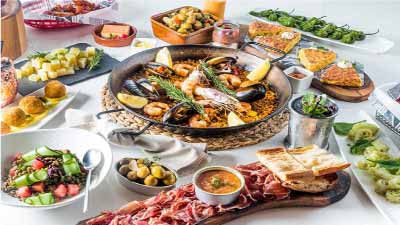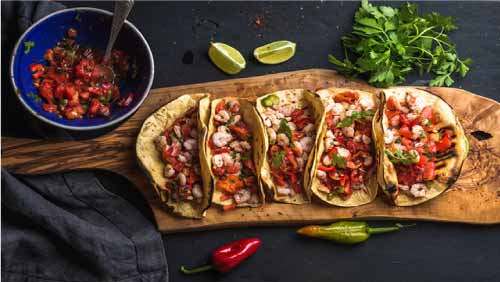Spanish gastronomy encompasses the culinary traditions of Spain. Its basic ingredient is olive oil, which forms the basis of many vegetable sauces. Most Spanish dishes also include many herbs, such as thyme, oregano, and parsley. Garlic is also common in Spanish cuisine.
Tapas
Tapas are small dishes to share that are part of Spanish cuisine. These small portions are made of meat, fish, vegetables, and sometimes dairy products. Most Spanish recipes are light on condiments and aromatic. The most common condiment in Spanish cuisine is garlic. It is used to flavor dishes such as bread with tomato and garlic prawns. Many tapas also contain bread. The bread is used as a base for pintxos (small, crispy crackers) or incorporated into a savory dish such as paella.
Spanish tapas have evolved from their Spanish origins to incorporate flavors from around the world. The Romans introduced olives, almonds, and spices to Spain, and these items eventually became part of Spanish cuisine. Over time, tapas spread around the world and influenced cuisines around the world. Some of today’s tapas restaurants offer dishes influenced by world cuisine, such as slow-cooked pork belly with herbs and spices.
Torrezno (fried bacon) is a popular Spanish tapa. This tasty snack is made from marinated pork belly that is fried until crispy on the side of the skin. It is one of the richest tapas in Spain and it is also cheap. A typical Spanish meal may include tapas or rations.
If you’re planning a night out in Spain, don’t forget to order tapas as an appetizer. These small plates are a great way to try a variety of dishes without ordering too much or spending a lot of money. They are also a great way to share with friends.
Iberian Ham
Jamon Iberico is a famous Spanish ham and is a cultural staple in Spain. You can find it hanging from the ceiling of Spanish houses. It has a unique salty aroma that makes the mouth water. Its origins date back to ancient times and it is an important symbol in Spanish gastronomy.
The production of Iberian ham is highly regulated. There are four main regions where ham is made, including the city of Salamanca and the city of Guijuelo. The best ham comes from the Huelva region of southwestern Spain, which has the perfect climate and humidity to cure the ham.
Iberian ham is sold throughout Spain. Spain produces approximately 40 million hams per year. About 5% of these hams come from Iberian pigs. These pigs are black-hooped, dark in color and almost hairless. The meat of these pigs is cured for three years and has a rich and sweet taste.
Iberian ham comes from the Iberian pig, which are unique in the Iberian Peninsula. They have jet-black hooves, dark gray fur and long legs. Its origin dates back to the ninth century when the Phoenicians brought domesticated pigs to the peninsula. Today, Iberian pigs are characterized by muscular legs, elongated snouts and black hooves.
When piglets are born, they are fed cereals and acorns. The pigs are then taken to nearby slaughterhouses where they are slaughtered in the most humane way. The regulations for the production of Iberian ham are strict and the meat must meet high standards to be considered Iberian ham. This ham can be expensive, with an average of up to 18 euros per 100 grams.
French toast
Torrijas are fried sweet breads. They can be served hot or at room temperature. They are a traditional snack in Spain and are a staple in most Spanish restaurants. A small plate is usually served with French toast. They are served with honey, cinnamon or sugar.
It is believed that torrijas originated in the early sixteenth century and were created by Spanish nuns. Their low-cost ingredients made them particularly attractive to a poorer community. In addition, they served as a substitute for meat during Lent, which was a time of fasting. They were also popular during Holy Week, when vegetarians and Christians abstained from eating meat. Historically, they were made with breadcrumbs rolled into a ball and soaked in syrup.
French toast is similar to French toast, although much more elaborate. The French toast is soaked in milk impregnated with aromatics from the Mediterranean. Then they are fried in olive oil. At the end, they are soaked in a sweet syrup and coated in cinnamon sugar.
Torrijas are no longer just for Easter. They are also a great way to recycle old breads and are a perfect treat for any occasion. However, they should be consumed with caution due to their high caloric content. They are easy to make: add milk to a saucepan and sugar. You can also add a cinnamon stick or orange peel to the mix.
Paella is part of Spanish gastronomy
Paella is a Mediterranean dish, where seafood, vegetables and meats are combined. The dish originated in the eighteenth century and is still an important part of Spanish gastronomy. While most paellas are delicious, there are some that are truly sublime. The dish has been adapted to use various types of meat and seafood, as well as spices.
Traditional paella doesn’t contain much broth, so you can freeze leftovers or reheat them in the microwave. Be sure to store them in a container with a lid or bowl, and cover them with plastic wrap. In this way, you can serve them in a couple of days. To reheat them, simply put them in the microwave or heat them on the stove over medium heat.
The history of paella is very varied, but there are some things that are universal. It was invented for the first time in the mid-nineteenth century in the region of Albufera, a lagoon near the city of Valencia. Farmers in the region mixed chicken, rabbit and vegetables and cooked them in a pan over the fire. Subsequently, they would add other ingredients, including fish, seafood and sausages.
The ingredients of paella vary depending on the region of Valencia where it originated. While the Valencian variety uses ingredients from the land, other Spanish varieties feature more seafood. In both cases, extra virgin olive oil, Spanish short-grain rice, water, salt and saffron are common ingredients in authentic paella recipes.
Jerez is part of Spanish gastronomy
The gastronomy of Jerez, Spain, is diverse and fascinating. The town boasts centuries-old Moorish architecture, a vibrant fish market and unique tabancos. You’ll also find an exciting flamenco scene and hard-working locals. It is a wonderful alternative city in southern Spain.
The region’s winemaking history has shaped the city’s cuisine and identity. That’s why many of the city’s restaurants offer bold and novel interpretations of traditional dishes. There are also gastronomic concepts that transcend traditional Spanish cuisine, such as tapas.
Among the many culinary delights in Jerez, gastronomic delights can include fresh fish and cheese. A Mercado Central de Abastos, located in the center of town, is a great place to try local specialties. It also has a bar called La Pampero, which serves fried hake.
The name of the restaurant refers to a grape that grew abundantly in the region two centuries ago. The restaurant’s décor is minimalist and emphasizes dishes and wine. Jonatan Cantero is responsible for the wine list. The wine list is also well thought out.
The city is 20 km from the coast and restaurants specializing in fish and seafood abound. Seafood in Rio Viejo costs EUR7 per 100g and local white wine is available at EUR2 by the glass. You can also try seafood at Alboronia, a fusion of Spanish and Moroccan cuisines.
Squid meatballs are part of Spanish gastronomy
To make the squid dumplings, we first cut the cuttlefish into bite-sized cubes. Then add a pinch of salt to the oil and sauté for 2-3 minutes. Meanwhile, finely chop the onion. Pour 125 ml of white wine, reduce and bring to a boil. Add the squid dumplings and simmer for a couple more minutes. Serve with potatoes.
Squid meatballs are Spanish tapas and are traditionally made with squid or cuttlefish. They are usually pureed in a food processor. You can also use a combination of meatball ingredients, such as egg and squid.
Spanish meatballs come in a variety of shapes and sizes. Some are made from pork or beef, and others are made with fish or squid. Meatballs are usually served with a tomato sauce. Another popular tapa is the croquette. Made with breadcrumbs and fried, croquettes are a favorite of Spaniards.
To prepare the squid dumplings, we first prepare the meat. Combine it with the egg yolk. Then, shape it into small meatballs about 3 cm in diameter. Then place it in the same pan you made with the bread and cook until golden brown all over.


